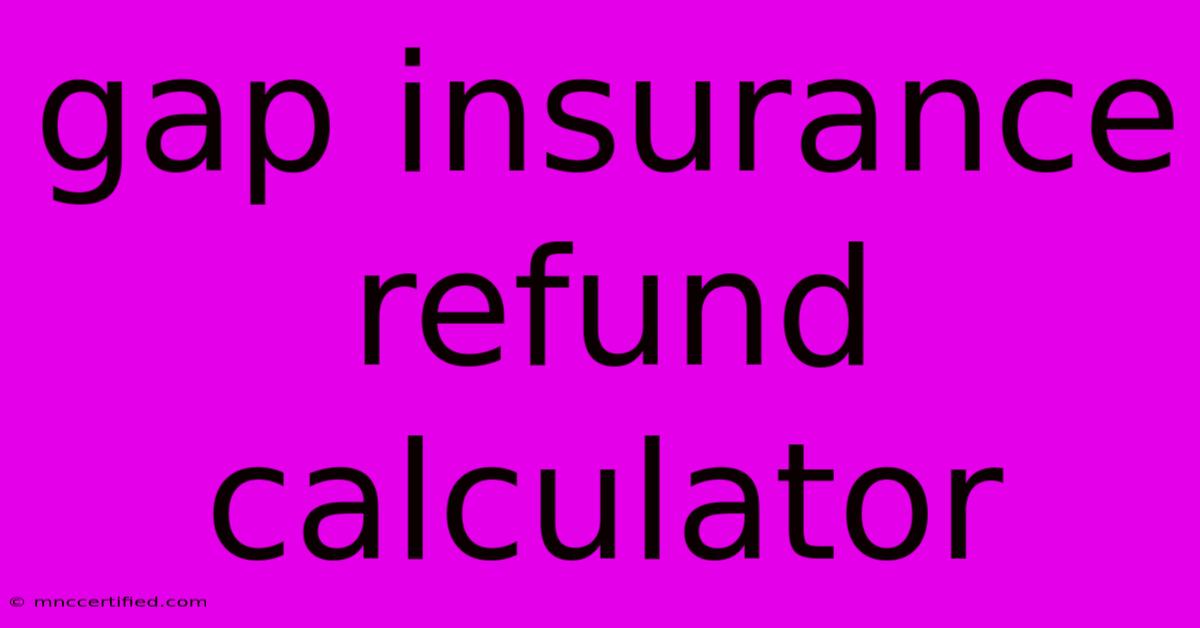Gap Insurance Refund Calculator

Table of Contents
Gap Insurance Refund Calculator: Reclaiming Your Unneeded Coverage
Are you looking to understand how much of a refund you might be eligible for on your gap insurance? Navigating the world of car insurance and figuring out potential refunds can be confusing, but this guide will help you understand gap insurance refunds and how to use a gap insurance refund calculator effectively.
What is Gap Insurance?
Gap insurance, or Guaranteed Auto Protection (GAP) insurance, covers the difference between what your car is worth (its actual cash value or ACV) and what you still owe on your auto loan or lease. This difference can be significant, especially in the first few years of ownership when depreciation is high. If your car is totaled or stolen, your standard auto insurance will only pay out the ACV, leaving you with a potentially substantial shortfall. Gap insurance steps in to cover this gap, ensuring you're not left with a hefty debt.
Why You Might Need a Gap Insurance Refund
Several scenarios might lead you to seek a gap insurance refund:
- Early Loan Payoff: If you pay off your car loan before the gap insurance policy expires, you likely have paid for coverage you no longer need.
- Policy Cancellation: Your circumstances might change, making the gap insurance unnecessary (e.g., you sell the car, the loan is paid, or the lease ends).
- Policy Errors: Mistakes in the policy terms or misrepresentation by the insurance provider might entitle you to a refund.
How to Use a Gap Insurance Refund Calculator
Unfortunately, there isn't a single, universally available "gap insurance refund calculator" like there might be for other financial products. The process for calculating your refund is specific to your insurance provider and policy details. However, here's a general approach to determine a potential refund:
-
Contact your Insurance Provider: The first and most crucial step is contacting your gap insurance provider. They possess all the necessary information about your policy, including the premium paid, the coverage period, and any applicable cancellation fees.
-
Gather Your Policy Documents: Locate your policy documents, including the insurance contract and any payment records. This information will be crucial when discussing your refund with the provider. Note the policy start date, policy end date, and the total premium paid.
-
Understand Cancellation Policies: Your policy will likely outline the terms and conditions for cancellation, including any potential penalties or fees. These fees can significantly reduce your refund amount.
-
Calculate Pro-Rata Refund (Estimate): While a specific online calculator is lacking, you can calculate a rough estimate of a pro-rata refund yourself. This involves determining the portion of the policy period you haven't used. For example, if you paid for a 36-month policy and canceled after 12 months, you might be eligible for a refund of 2/3 of the premium (minus any cancellation fees).
Example: If your total premium was $500 and you canceled after 1 year of a 3-year policy, your potential pro-rata refund would be roughly $333. Remember, this is a rough estimate, and the actual refund might differ.
- Negotiate with Your Provider: Be prepared to negotiate with your provider. Clearly explain your reasons for seeking a refund and present all relevant documentation.
Finding Information About Your Specific Provider
To find information relevant to your specific gap insurance provider, search online using terms like "[Your Insurance Provider Name] gap insurance refund policy" or "[Your Insurance Provider Name] gap insurance cancellation".
This targeted approach will help you locate the information you need directly from the source.
Key Considerations
- Cancellation Fees: Be aware that cancellation fees often apply. These can significantly reduce your refund.
- State Regulations: State regulations regarding insurance cancellations and refunds vary. Familiarize yourself with your state's laws.
- Documentation: Keep meticulous records of all communication and documentation related to your refund claim.
By following these steps and understanding the process, you can increase your chances of successfully obtaining a refund for your gap insurance. Remember, proactive communication with your insurance provider is key to a smooth and efficient process.

Thank you for visiting our website wich cover about Gap Insurance Refund Calculator. We hope the information provided has been useful to you. Feel free to contact us if you have any questions or need further assistance. See you next time and dont miss to bookmark.
Featured Posts
-
Controlled Blast Near London Embassy
Nov 23, 2024
-
Insurance Agents Panama City Fl
Nov 23, 2024
-
Gatwick Terminal Reopens Bomb Scare Ends
Nov 23, 2024
-
Maga Coin Price Prediction 2030
Nov 23, 2024
-
Bogdanovich Chers Asshole Comment On Mask
Nov 23, 2024